Photos with this report (click to enlarge) | |||
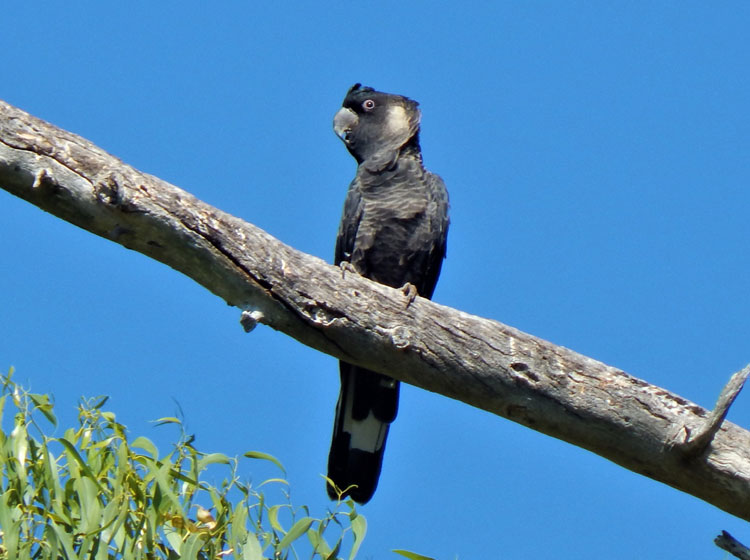 Carnaby's Black Cockatoo |
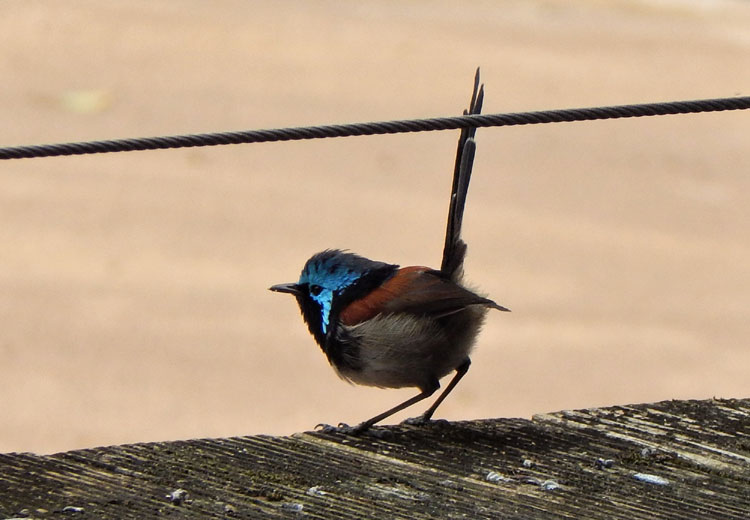 Red-winged Fairy-wren |
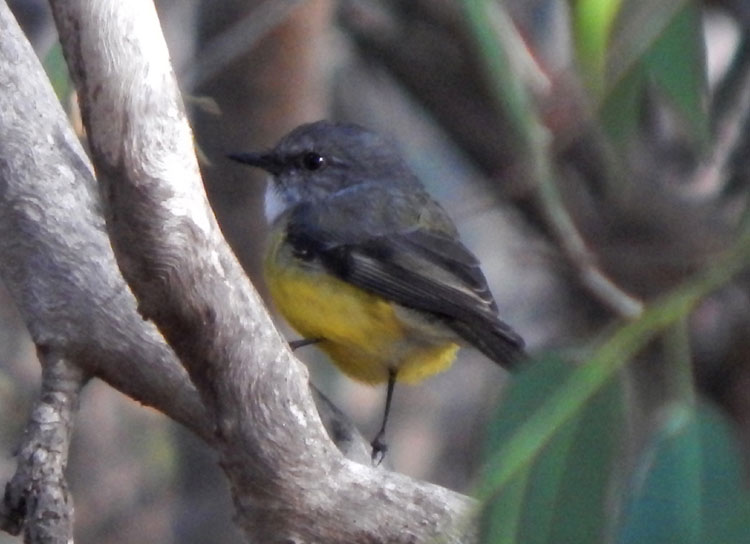 Western Yellow Robin |
|
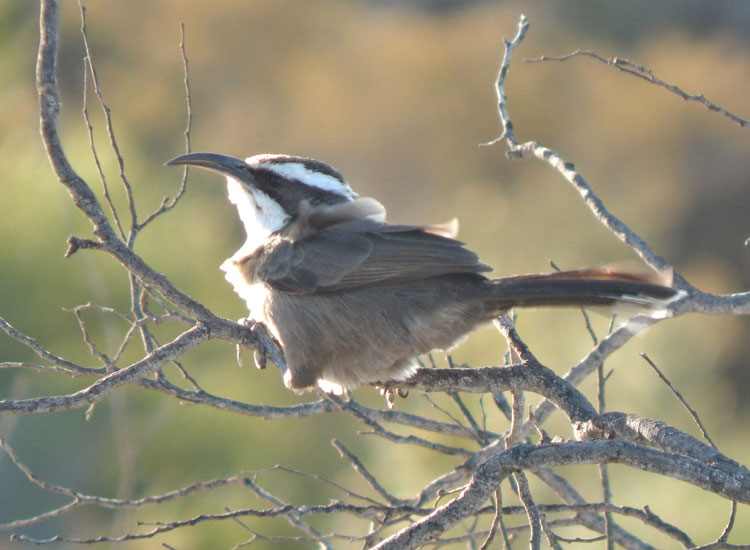 White-browed Babbler |
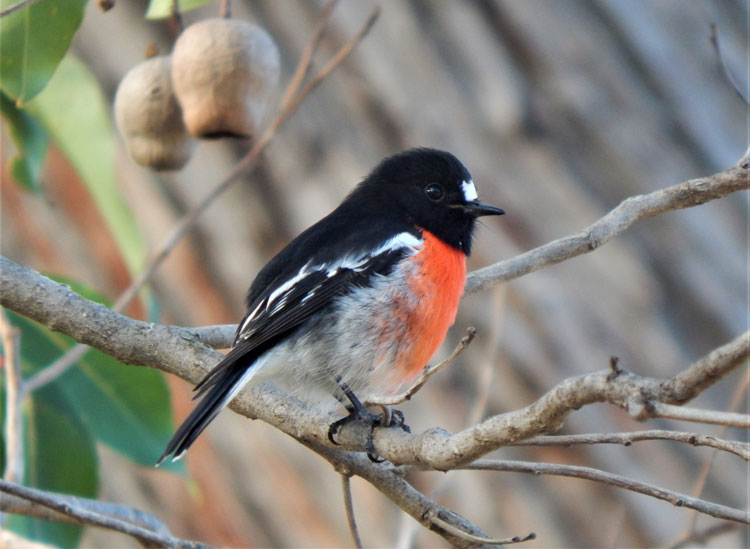 Scarlet Robin |
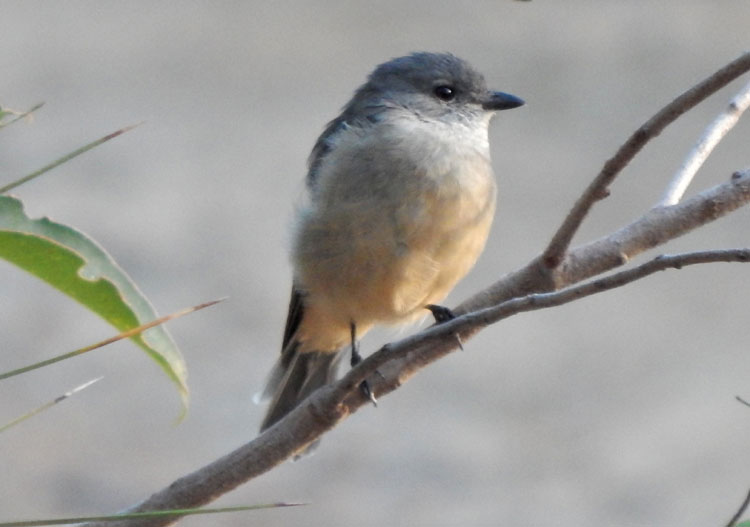 Western Whistler |
|
This was a follow-up trip to a similar one in Dec 2004-Jan 2005. We spent 2.5 weeks in SW Australia, visiting relatives but also birding at key sites to look for the region’s endemics and to pick up birds not seen on our previous trip. We spent a lot of time based at Gooseberry Hill in the Darling Range just outside Perth but also undertook a week travelling north to Monkey Mia via Kalbarri, as well as a shorter trip south to the Margaret River area. We borrowed a friend’s car for the entire duration of our stay and booked ahead in guest lodges (essential for Monkey Mia in particular). We saw some 200 species and had great views of most of the SW Australian endemics including Western Grasswren and several birds missed in 2004-05 such as Pied and Black Honeyeaters, Malleefowl, Crimson Chat and Southern Scrub-robin.
Itinerary
• 13 -17 Mar: arrival at Perth airport and a week of birding in the Perth Hills / Darling Range National Parks including Bull’s Rapids, Mundaring Weir, Lake Leschenaultia, Yanchep and Lesmurdie Falls
• 18 Mar: drive north from Perth, birding along the way on inland route and overnight at Mullewa
• 19 Mar: drove inland route from Mullewa to Kalbarri via the Hutt Lagoon, stopping to bird along the way
• 20-21 Mar: stayed at Kalbarri, birding the N.P. and environs
• 22 Mar: early morning birding Kalbarri and Murchison River crossing before long drive north to Monkey Mia
• 23-24 Mar: stayed at Monkey Mia, birding the N.P. and environs
• 25 Mar: early morning birding Monkey Mia and Shark Bay peninsula before long drive south to Dongara
• 26 Mar: early morning birding Dongara before drive along coastal route back to Gooseberry Hill
• 27 Mar: drive south to Dunsborough
• 28-29 Mar: stayed at Dunsborough, birding the environs south to Hamelin Bay and Boranup N.P.
• 30 Mar: early morning birding Dunsborough before drive north back to Gooseberry Hill via stopes at Bussleton and the Tuart Forest
• 31 Mar: final day’s birding at Goosebery Hill / Kalamunda before late flight from Perth back to Edinburgh
Principal sites
The main birding sites we birded are listed below.
1) Perth Hills:
a) Gooseberry Hill and Kalamunda. The large leafy gardens and adjacent open heathy bush again produced a wide range of species including lots of Red-crowned Parrots, Rainbow Lorikeets, Galahs and Australian Ring-necks and regular parties of Short-billed Black (Carnaby’s) and Red-tailed Black Cockatoos, plus occasional Little Corellas. Other common garden birds included Laughing Kookaburra, Australian Magpie, Australian Magpie-lark, Red Wattlebird, Common Bronzewing, Spotted Dove and Silvereye, whilst the gardens and adjacent heathy areas held a wide variety of honeyeaters including Singing, Brown and New Holland Honeyeaters and Western Spinebill, as well as Gilbert’s Honeyeater on flowering eucalypts. Other regularly seen birds in better habitat included Western Wattlebird, Scarlet Robin, Splendid Fairy-wren, Striated and Spotted Pardalotes, Grey Fantail, Western Gerygone, Weebill, Yellow-rumped Thornbill, Inland Thornbill, Western Thornbill, White-browed Scrubwren, Western Whistler, Rufous Whistler, Grey Shrike-thrush, Grey Butcherbird and Black-faced Cuckoo-shrike, plus regular Brown Goshawk, Welcome Swallow and Australian Raven overhead and occasional sightings of Square-tailed Kite, Whistling Kite, Australian Hobby and Collared Sparrowhawk. Unlike in 2004/05, Southern Emu-wrens and Blue-breasted Fairy-wrens were present in the flat heathy areas of Mundy Regional Park, which had recovered from fire damage. Southern Boo-book was also new here, calling regularly after dusk, but Laughing Doves (common in 2004/05) were conspicuously absent.
b) Swan Valley and Bull’s Rapids. Straw-necked Ibis and Maned Ducks were widespread on pasture in the Swan Valley, whilst the pools at Bull’s Rapids added Little Pied Cormorant, Australasian Darter, White-faced Heron, Great Egret, Coot, Pacific Duck, Grey Teal and a lone Hooded Robin.
c) Yanchep N.P. Lake McNess has contracted considerably and there was much less open water than in 2004. Outstanding here was a noisy flock of 100+ Carnaby’s Black Cockatoos in tall trees around the visitor centre area. Western Swamp-hen, Black-tailed Native-hen, Maned Duck, Australian White Ibis and Straw-necked Ibis fed on the lawns, whilst the lake itself held Dusky Moorhen, Black-winged Stilt, Pacific Duck and Australian Shelduck in amongst the Grey Teal. There were Welcome Swallows and Fairy Martins overhead, a Whistling Kite and an Australian Swamp Harrier hunted over the lake and Willie Wagtails, Little Crows and Splendid Fairy-wrens were common in the garden areas. The trail around the lake was good for commoner bush birds (already seen), as well as a confiding White-breasted Robin and Red-winged Fairy-wrens in wetter woodland at the lake edges.
d) Mundaring Dam. A pleasant reservoir with intact adjoining woodland that yielded more Red-tailed Black Cockatoos, a Grey Currawong and a group of 8 Varied Sitellas (hard to pin down in the Perth Hills area it seems), plus Little Black Cormorants on the reservoir.
e) Lake Leschenaultia – This popular spot includes a quiet trail around the shallow lake fringes, which looked great for crakes (early morning visits needed). We picked up several Australian Reed Warblers here in the emergent vegetation, as well as 2 Musk Ducks, Australian Little Grebes, Black Swans, 12 Red-tailed Black Cockatoos and many commoner bush and lake species already seen.
2) North to Monkey Mia via Kalbarri
a) Drive north to Mullewa. We drove north from Perth along an inland route via New Norcia to Mullewa. We saw plenty of commoner roadside raptors such Australian Kestrel, Black-shouldered Kite and Whistling Kite, plus a flock of c100 Little Corellas. A stop at Coorow produced Western Corellas (northern-race) and yet more Red-tailed Black Cockatoos. Broad strips of intact Mallee-type habitat along the road-sides between Coorow and Mingenew looked good and stops produced a striking male Pied Honeyeater, a Bourke’s Parrot and our first Pied Butcherbirds of the trip. Regular stops in similar habitat between Mingenew and Mullewa produced many nice inland bush/agricultural birds including Pallid Cuckoo, Diamond Dove, Brown Songlark and Australian Pipit, plus 3 Stubble Quail as well as a range of commoner wood-swallows and honeyeaters.
b) Mullewa to Geraldton. An early visit to Mullewa Common produced a flock of 10 Zebra Finches, close views of a Brown Falcon, plus Laughing Doves, Crested Pigeons and Tree Swallows, which were all new for the trip list but none of the hoped-for Australian Bustards. Slow driving with stops in the roadside woody/scrubby strips between the wheat fields heading towards Geraldton produced many birds with the highlights being 5 Black Honeyeaters, 2 White-eared Honeyeaters, a party of 6 Chiming Wedgebills and 2 Mulga Parrots along with commoner bush birds such as many Brown and Singing Honeyeaters, Western Wattlebird, Grey Currawong, Rufous Songlark, Black-faced Cuckoo-shrike and 2 Peaceful Doves. Yellow-throated Miners were new for the trip-list in the suburbs of Geraldton as was a White-plumed Honeyeater visiting a garden at Northampton.
c) Hutt Lagoon and Port Gregory. Stops along the shore of Hutt lagoon and at Port Gregory on the way to Kalbarri, produced a range of wetland birds on roadside pools including 300 Banded Stilt, 100 Red-necked Avocet, 200 Black-winged Stilt and smaller numbers of Red-necked Stint, Lesser Sandplover, Sharp-tailed Sandpiper and Whiskered Tern, plus a flock of Brown-headed Honeyeaters in the coastal scrub. The beach at Port Gregory held 2 Pacific Gulls, Australian Pied Oystercatcher, 20 Crested Tern and Great Cormorant, plus many Silver Gulls, whilst pools on the edge of town yielded our first Red-kneed Dotterel.
d) Kalbarri. Checks of the bay and rocky Oyster Reef (far shore) produced plenty of the commoner gulls, cormorants, egrets (including Eastern Reef Egret) and terns, plus a few Roseate Terns and at least one Fairy Tern, as well as Osprey and White-bellied Sea-eagle. Strong onshore winds for most of our stay produced many close Wedge-tailed Shearwaters and Australian Gannets when sea-watching from the seaward side of Chinaman’s Point, plus at least 10 Little Shearwaters.
i) Coast south of Kalbarri. A nice walk in arid, rocky coastal heath to Eagle Gully produced Rufous Fieldwren (formerly Striated Calamanthus), Variegated Fairy-wren, 2 Redthroats and several Australasian Pipits and Singing Honeyeaters, with many Wedge-tailed Shearwaters and Australian Gannets offshore. We also bumped into a flock of chats on the drive in to the car park, which involved mostly White-fronted Chats but also 5 stunning Crimson Chats. There were many close Wedge-tailed Shearwaters off the coast at Blue Holes, plus an Eastern Reef Egret.
ii) Big River Ranch / River tracks– just outside the NP, Janet went horse-riding here whilst I took the chance to bird this area of private dry fields with dry scrub and riverine woodland on foot, which had been very productive in 2004 and it did not disappoint. The rough fields and dry scrub produced a flock of 50 Zebra Finches, 2 Southern White-faces, 2 Redthroats, an Emu (!), Black-faced Cuckoo-shrikes and a Red-backed Kingfisher, plus Chestnut-rumped Thornbills, Inland Thornbills, Weebills, White-browed Scrub-wrens and Western Gerygones in taller dry woodland. A small patch of wetter Eucalypt woodland near the river held a pair of Western Yellow-robins, 4 Western Whistlers, a Fantail Cuckoo and great views of a surprise Grey-fronted Honeyeater. A big mixed flock of fairy-wrens here (40+birds!) included at least 12 White-winged Fairy-wrens as well as Variegated, Blue-breasted and Splendid Fairy-wrens. A Royal Spoonbill was a surprise on the river, together with more expected Caspian Terns, Australian Pelicans, Greenshanks and Great White Egrets, plus Whistling Kite, Osprey and White-bellied Sea-eagle.
iii) Meanarra Hill – the new walking trail at Meanarra Hill (just inland from town) passes through some great Mallee habitat and is recommended. I birded it hard from 0630-0830hrs. Malleefowl was new for me here – one was calling out of sight from the hill but the other walked across the entrance road in front of the car (drive slowly!). White-browed Babbler was common along the trail, but I also had a great view of Shy Hylacola here and tracked down a Southern Scrub-robin calling in the Mallee. 2 Elegant Parrots were less expected feeding on low mats of vegetation in a cleared area around radio masts at the hill-top. Other birds along the trail included Inland, Western and Chestnut-rumped Thornbills, Weebill, Grey Shrike-thrush and Western Wattlebird.
e) Drive north: Kalbarri to Monkey Mia. An early morning drive east through Kalbarri N.P. produced another Emu but sadly no Australian Bustards. There were many honeyeaters in the flowering roadside Banksias including several White-fronted Honeyeaters, plus another flock of Zebra Finches.
i) A stop at the Galena rest-site on the Murchison River was excellent for water-birds with highlights being Pink-eared Duck, 4 Black-fronted Dotterel, Red-kneed Dotterel and a Wood Sandpiper in amongst hordes of commoner waterfowl and waders, whilst the adjacent scrub held a White-plumed Honeyeater, White-winged Fairy-wrens, Hooded Robin and Zebra Finch.
ii) Murchison River to Overlander rest-site. Fairly quiet roadside birding in 35 degrees of heat yielded a bonus Grey Falcon, that flew low in front of the car and perched briefly on a dead tree close to the road (no traffic so an emergency stop was called for), plus the more expected 5 Emus, Zebra Finch flocks, Little Eagle and Black-winged Kites etc
iii) A stop at Hamelin Pool to view the stromatolites was hampered by heat (40+ degrees!) but yielded White-plumed Honeyeater and Zebra Finch near the village store, plus some very confiding Welcome Swallows gathering in the shade of the board-walks.
iv) Hamelin Pool to Monkey Mia. A long drive through much excellent arid habitat was largely bird-less during the heat of the afternoon with just White-bellied Sea-eagle noted closer to Denham and 8 Emus east of Denham. However, the return route was much more interesting in the cooler morning with several Wedge-tailed Eagles and a Black-breasted Buzzard noted, more Zebra Finches, a flock of Crimson Chats, many White-browed Babblers, at least one party of Grey-crowned Babblers, a group of Chiming Wedgebills, a Chestnut-breasted Quail-thrush feeding unconcerned in the shadow of taller roadside scrub and best of all, an Orange Chat actually perched on the road in salt-flat country close to Hamelin Pool.
3) Monkey Mia and Shark Bay:
a) We stayed at Monkey Mia and I birded the nature trail area regularly. The target bird here is Western Grasswren and I found them several times (especially in the late afternoon), always on the fringes of the main car parking area where they were often very unobtrusive. The nature trail produced many White-browed Babblers, Variegated Fairy-wren, White-winged Fairy-wren, Southern Scrub-robin (singing), Mistletoebird and good views of a couple of rather elusive Slender-billed Thornbills, plus 1 Square-tailed Kite. The resort area itself regularly held Emus as well as Spiny-cheeked, Singing and White-plumed Honeyeaters, Silvereyes, Little Crows and Australian Pipits, plus a bonus Brown Goshawk. The coastline south of the resort was productive for water-birds with many roosting on a spit including Fairy Tern, Caspian Tern, Lesser Crested Tern, Crested Tern, White-faced Heron and Australian Pelican, plus waders such as Bar-tailed Godwit, Greenshank, Red-capped Plover, Red-necked Stint, Curlew Sandpiper, Knot, Australian Oystercatcher and 2 Marsh Sandpipers.
b) Little lagoon. This site just before Denham, includes a mangrove-lined creek that holds several birds at the very southern edge of their range. We drove here early in the morning and walked the trail along the creek. First up was a confiding Striated Heron, quickly followed by a group of Yellow White-eyes (Silvereyes are also present here so take care when checking for the rarer species). Scanning the mangroves on the far bank of the creek eventually produced a couple of the hoped-for Mangrove Grey Fantails. Also present were Osprey, White-browed Scrub-wren, Variegated and Splendid Fairywrens plus Hoary-headed Grebe and Great White Egret in the creek. Tree Martins fed over the creek whilst nearby scrub held some very vocal Chiming Wedge-bills. The beach here was also very productive for water-birds with many of the species seen at Monkey Mia present (including Fairy and Lesser Crested Terns) as well as Greater and Lesser Sandplovers, Whimbrel, Grey Plover, Terek Sandpiper and Little Egret.
c) Dongara. On the way south from Shark Bay we stayed overnight in a small resort at the Irwin River mouth, Dongara, which produced some nice birding the following morning. Trails around the headland produced a surprise Rock Parrot, plus Weebill, Collared Sparrowhawk and Splendid Fairy-wren, whilst the wetland trails produced a nice range of commoner water-birds including Pink-eared duck, Musk Duck, Chestnut Teal and Caspian Tern. Spotted Harrier was also present just south of the town.
d) Coomallo conservation area. We drove back to Perth on the Brand Highway and stopped off at the picnic area in the Coomalloo Nature Reserve. The taller trees along the creek were full of honeyeaters including at least 10 Tawny-crowned Honeyeaters, as well as several White-cheeked Honeyeaters and Brown-headed Honeyeaters, plus Weebill, Striated Pardalotes and Tree Swallows.
4) Dunsborough and the SW.
Although we had covered the SW tip of Australia well on our last trip, it was nice to go back and see some forest birds in pleasantly cool conditions (low 20s degree centigrade). We stayed in a property on the aptly-named (Common) Bronzewing Road, which was surrounded by nice Jarrah woodland and early morning strolls here produced good views of common bush birds such as Splendid Fairy-wren, Scarlet Robin, Western Whistler, Grey Shrike-thrush, Grey Fantail, White-browed Scrub-wren, Inland Thornbill and Red Wattlebird plus fly-over Western Rosellas and noisy groups of Red-tailed Black Cockatoos.
a) The drive south to Hamelin Bay produced groups of Carnaby’s Black Cockatoos and Red-capped Parrots in the open woodlands. Hamelin Bay itself was busy with visitors watching the very confiding stingrays in the shallows. Pacific Gulls and Silver Gulls were confiding and photogenic here, plus there were several Flesh-footed Shearwaters offshore. We had to walk well away from the crowds towards the north end of the beach to find 2 Hooded Plovers.
b) Boranup NP. The huge Karri trees are impressive in this densely-wooded NP but a walk along the main track also produced great views of Rufous Treecreepers, Red-winged Fairy-wrens, Gilbert’s Honeyeaters and a White-breasted Robin, plus groups of Purple-crowned Lorikeets feeding high in the trees and more Western Whistlers, Grey Currawongs and other common bush birds, although no Red-eared Firetails.
c) Bunker Bay. The small swamp next to the café (excellent muffins!) held a White-breasted Robin and more White-browed Scrub-wrens, whilst the casuarinas at the back of the beach held a very quiet party of Baudin’s (Long-billed) Black Cockatoos and there were Australian Gannets offshore.
d) Bussleton area. An afternoon visit to the Malbup bird hide on the Vasse Estuary, adjacent to the Tuart forest reserve produced no water-birds at all and just a lone Swamp Harrier and a few common bush-birds – this area had been very productive on a previous trip in January.